The quest to explore Colombia’s untouched jungle
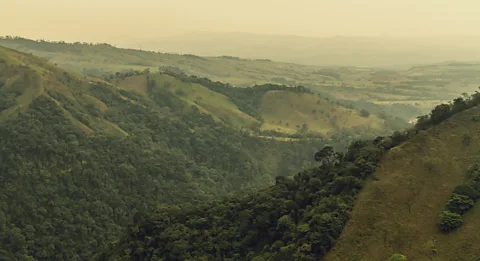 Sergio Fabara
Sergio FabaraColombia is on a mission to make sense of its rich biodiversity, isolated thanks to years of war. For researchers, it is a golden opportunity – and a breathtaking adventure.
BBC Future has brought you in-depth and rigorous stories to help you navigate the current pandemic, but we know that’s not all you want to read. So now we’re dedicating a series to help you escape. We’ll be revisiting our most popular features from the last three years in our Lockdown Longreads.
You’ll find everything from the story about the world’s greatest space mission to the truth about whether our cats really love us, the epic hunt to bring illegal fishermen to justice and the small team which brings long-buried World War Two tanks back to life. What you won’t find is any reference to, well, you-know-what. Enjoy.
With a TV-dish-shaped object sticking out back, and a rifle hanging over his shoulder, Glenn Seeholzer looks fantastically out of place in the middle of the jungle. He is chasing an elusive bird of early morning habits and a shrill whistle. So far, he hasn’t found it.
He has spent the last two weeks prying the forests near Medina, a small town near the Chingaza National Park, in central Colombia. With 59 other researchers, he is part of the Colombia Bio expedition, a two-week expedition with the mission of trying to understand its biodiversity.
Seeholzer, a postdoctoral fellow at the American Museum of National History in New York, and a collaborator at the Alexander von Humboldt Institute in Colombia, wants to record the song of a dusky-capped flycatcher (Myiarchus tuberculifer), and then hunt down the same bird he recorded. It is a mission that should answer questions about one of evolutionary science’s great mysteries: what leads to the formation of new species?
You might also like:
He wakes before sunrise, puts on his hiking shoes, and heads uphill to the forest at a frantic step. He only has 30 minutes to catch it: this bird sings its ‘dawn song’, its most distinctive call, in the small window between the end of the night and the beginning of the day.
As if someone pushes a switch inside of him, he goes into stealth mode when he heard the bird for the first time. He starts to follow the whistle without making any noise, walking and breathing as silently as he can. The low bushes, muddy patches, and sharp stones of the forest make it difficult; his deaf right ear makes it even worse.
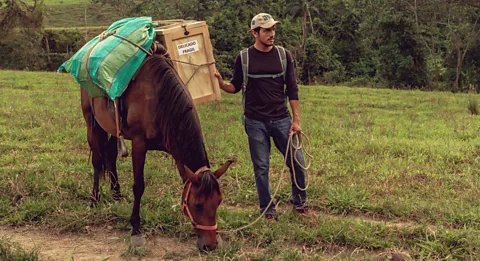 Sergio Fabara
Sergio FabaraThe bird whistles again, and Glen aims his antenna at it. It is a parabolic microphone that can isolate a bird’s whistle from the noise of the forest. Then he waits for it to sing one more time – but it moves. If it stood still, he would try to put a sand-grain-sized bullet somewhere in his chest.
A couple of years ago, walking around this forest at dawn with a rifle and an odd backpack would have been suicidal. The guerrillas from Colombia’s left-wing revolutionary army Farc wouldn’t have cared if you were doing it in the name of science.
The war
“I used to advise my students to remember that Shakira song Ciega, Sordomuda,” Jhon Cesar Neita says one night. It was a survival rule of thumb: the song’s title translates as ‘blind, deaf-mute’.
Neita is a veteran entomologist who had to learn how to deal with the Colombian conflict to do his field work. He studies coprophagous beetles, those who eat other animals’ faeces. Chasing them in the thick forests of the Colombian Pacific region often meant meeting guerrillas or paramilitaries face-to-face.
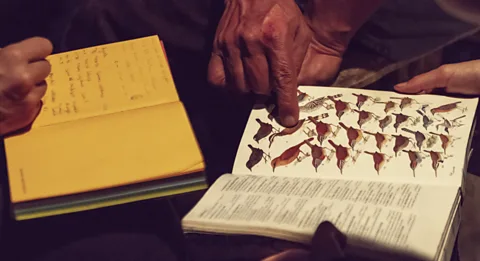 Sergio Fabara
Sergio FabaraThis is a familiar story among Colombian biologists. For decades, asking for permission from the area’s ruling army was standard procedure for planning a field trip. Sticking to their often-changing orders, making room for a guerrilla or paramilitary soldier in the research team, and avoiding the zones where they didn't want an indiscreet eye were all matters of life or death.
If the local commander said the trip was over, they all had to pack and leave before dusk. If the chief had questions to ask, the team was held hostage until they were answered, sometimes for several days. If he didn’t like the answers, someone was murdered.
When the Farc guerrillas signed a peace agreement with the Colombian government in 2016, the violence in many rural zones fell significantly. The end of the war not only meant a long-awaited reprieve for millions of people who live in remote areas of the country, but meant biologists and other researchers could now explore the country’s forests, rivers, and mountain zones.
They jumped at the opportunity. Colombia is regarded as the second-most-biodiverse country in the world, but its fauna and flora have evaded study because of the war. The government has now started the Colombia Bio programme which will fund 20 expeditions to remote zones where fighting has limited research.
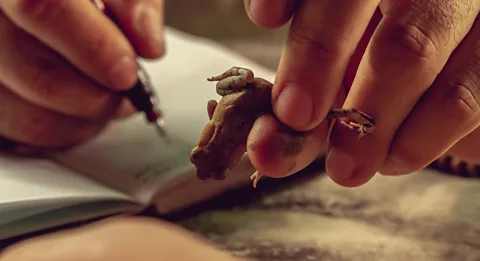 Sergio Fabara
Sergio FabaraThe primary goal of these expeditions is to make sense of Colombian biodiversity. But there is also the question of what can be done with it. “Biodiversity is the answer for many needs. Most medicines come from biodiversity. It is used in food, health, and cosmetics," says Hernando Garcia, deputy director of the Humboldt Institute. The Colombian government wants these expeditions to be the first step in creating new businesses based on the country’s plant and animal resources, from bird watching to pharmaceutical research.
In them, researchers go deep inside a remote area to obtain plant and animal samples, often by walking for hours in harsh environments. All this information will feed the Colombian Biological Information System, and many of the preserved bodies and organs will end up in the Humboldt institute’s collection, where they will be available for other researchers in the future.
Medina and the Chingaza Natural Park used to be strongholds for Farc guerrillas. In 2002, they blew up a dam there, a part of the system that provides water to the capital Bogota. They hid their hostages in the middle of the forest, and the traces of their encampments remain. Not far from where the researchers have been sleeping, there is an abandoned lodge that used to be a Farc camp.
It is an interesting place for biologists to explore. “Three worlds clash there: the prairies from the Orinoco river, the Andean forest, and some Amazonian elements,” explains Andres Cuervo, a senior biologist at the Humboldt Institute. The last expedition to the area was in 1997, and it didn't really get a lot of information.
Getting there is hard. You have to take a small bus from Bogota to Medina. Then you have to hire a car that will get you to a small village next to the mountains. You have to walk from there, but the equipment and food must travel in pack mules. It is a one-hour uphill walk to the first campsite. The second is two and a half hours away, through a path covered by thick forest and as steep as a flight of stairs.
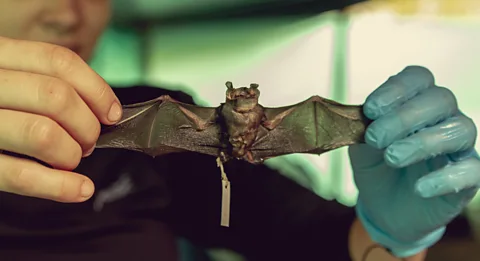 Sergio Fabara
Sergio FabaraNo wonder the guerrillas wanted to control the zone. It is the perfect place to hide.
From the forest to the lab
Did war shelter Colombian nature from destruction? It is hard to know. Guerrillas and paramilitaries may have helped isolate forests from deforestation and exploitation, but “there were a lot of brutal environmental impacts”, says García. The destruction of oil pipes contaminated bodies of water in many parts of the country, and landmines or bombs could have killed big mammals, like bears or jaguars. So far, the effect of the conflict on the local ecosystem is largely unknown.
That is why Andrés Acosta was so happy to have found this little goldish frog, a Rhaebo glaberrimus. “They only breed in water bodies that meet certain conditions, and need well-preserved habitats, like tropical rainforests,” he says, holding it in his hands. Finding it is a good clue that this forest is in good shape.
Acosta and his team go out in the evenings, as the forest becomes louder and darker. With no other light source than their headlamps, they move mostly by ear through narrow patches of mud and slippery stone. They stop whenever they sense a croak – a piping sound, hard to distinguish from a cricket’s chirp. Suddenly, someone snatches a frog from a leaf and puts it in a white cotton bag. They do this dozens of times through the night. It always looks like a magic trick; frogs seem to come out of nowhere.
The next morning, Erick Higuita and Mariana Cruz are walking through the same forest. They are looking for the for the orange cloth stripes that signal where the mousetraps are. They left them next to big trees, where rodents were likely to forage the fruit that fell off. The bait is a sticky mix of banana, peanut butter, vanilla and honey. “The sweet scent attracts rodents”, says Cruz. Indeed, it smells like a bakery.
It is not a productive day: they only catch a dark grey rat that seems to belong more to a city sewer than to a forest. Higuita starts to work on it. First, he takes out its insides and cleans the fur thoroughly: if he leaves just a piece of tissue, ants would feast on the body. Then, he fills it with cotton, and straightens its paws with a wire, taking care to leave them intact – "the foot pads are useful for identifying the animal”, he explains. Four hours later, the mouse is drying in the sun. It is now a stuffed animal, getting ready for rigid immortality behind museum glass.
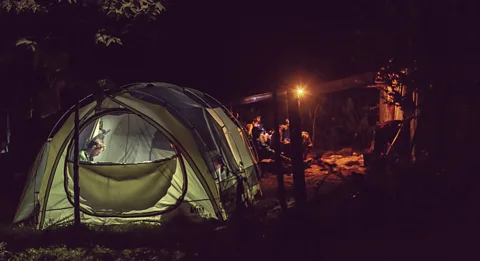 Sergio Fabara
Sergio FabaraIn the next table, Acosta is getting ready to do his own work. He starts by putting the frogs, one by one, inside a photo lightbox. Then, he takes some notes and shoots some pictures. Once all have been photographed, he pours some anaesthetic onto a cotton tip and rubs a frog with it. It dies in less than a minute, without any pain. Its body becomes flabby, its skin shiny.
A grey-haired man who has been in the business of frog-catching since his childhood, Acosta knows all the little tricks. He can spot the species of a frog as fast as a mother can tell the names of her kids. He writes with an old fountain pen because their ink doesn't slip if the notebook falls into a river. He brings his own tools, alcohol, and formaldehyde, because "you never know what someone else buys". He prepares and kills his frogs in the same order he caught them, because he has "to keep the ‘chain of custody', so to speak".
The final step is putting a needle over the flame of a burner until it burns red, piercing the frog with it, extracting some sticky tissue and putting it inside a steamy container filled with liquid nitrogen: its DNA is going to be scanned.
Scanning DNA is necessary because it helps us understand diversity at a deep level. Two seemingly different specimens may have very similar genes, or there could be substantial differences between two examples that look alike. “The genetic diversity is hidden and less explored, but offer crucial insight for understanding diversity, species distribution, and evolution”, says Maylin Gonzalez, a genetics researcher at the Humboldt Institute.
Each of the 55 species of crickets, 70 species of butterflies, 200 plants, 200 species of birds, 25 species of amphibia and reptiles, and 21 species of mammals found will have its DNA coded. The samples obtained here will feed a worldwide database of DNA barcodes, one which aims to become the largest biodiversity register ever built.
DNA can tell how healthy the population of any animal is, and how vulnerable they are to potential disease. It is also a living record of a species' history, and hence, of a zone's level of conservation. It is the ultimate judge of biologists' work: it can reveal if a specimen is what it was once identified to be.
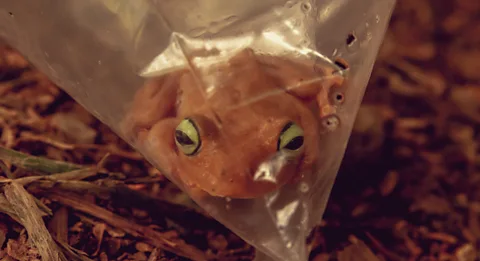 Sergio Fabara
Sergio FabaraDNA is also the reason why Seeholzer is chasing this elusive bird.
Something happened on the flycatcher’s yearly trip. The Peruvian part of the Andes was too high for them to fly over, so they split. Half of the flock went east of the mountains, half went west. They would meet again later; but after years doing the same thing, one day the groups couldn’t breed with each other.
By most standards, they became separate species. But it is more complicated than that. "They seem like two distinct species, but at the same time, they are one species. That is a ring species,” he explains.
He aims to study the speciation process as it happens. His research is about whether or not the song has a role in it. “To do that, it is really important to have genetic samples that are connected to song samples, and the only way to do that is to record the bird and then collect it, so you have the connection between the song, the plumage and the genetics.” He has a lot of specimens and a lot of recordings, but he still has not found a one-to-one correspondence between the two.
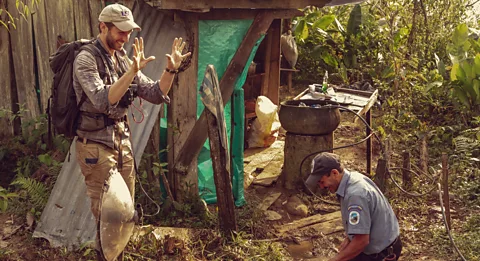 Sergio Fabara
Sergio FabaraAfter his hunt, he spends the rest of the day helping other ornithologists with their collections, or just exploring the forest. Even when the hard work begins to take a toll on most other researchers, he still has the energy to go and climb an old tree with a local guide. “I spent many months locked down in an office in New York,” he says.
A lot of paperwork is overdue when he gets back. Moving biological material between countries is a long process. He has to wait for some DNA results that could take a year. There are papers to write, meetings to attend, bureaucracy to go through. In the camp, other scientists half-jokingly suggest he to go back to Colombia and do his research there. He replies, half-jokingly, that he just might.
The final day, as he hiked back to the real world, he had an epiphany, he says. He will go to the forest more often. It will be a more exciting and productive life, one with less office and more nature. He’ll move to Colombia in a few months, he says from his NY office. “The time in the camp feels so short.” And he still has a flycatcher to find.
--
If you liked this story, sign up for the weekly bbc.com features newsletter, called “If You Only Read 6 Things This Week”. A handpicked selection of stories from BBC Future, Culture, Capital, and Travel, delivered to your inbox every Friday.
